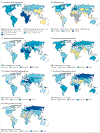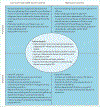HIV and cardiovascular disease
- PMID: 32243826
- PMCID: PMC9346572
- DOI: 10.1016/S2352-3018(20)30036-9
HIV and cardiovascular disease
Abstract
HIV-related cardiovascular disease research is predominantly from Europe and North America. Of the estimated 37·9 million people living with HIV worldwide, 25·6 million live in sub-Saharan Africa. Although mechanisms for HIV-related cardiovascular disease might be the same in all people with HIV, the distribution of cardiovascular disease risk factors varies by geographical location. Sub-Saharan Africa has a younger population, higher prevalence of elevated blood pressure, lower smoking rates, and lower prevalence of elevated cholesterol than western Europe and North America. These variations mean that the profile of cardiovascular disease differs between low-income and high-income countries. Research in, implementation of, and advocacy for risk reduction of cardiovascular disease in the global context of HIV should account for differences in the distribution of traditional cardiovascular disease risk factors (eg, hypertension, smoking), consider non-traditional cardiovascular disease risk factors (eg, access to antiretroviral therapy with more benign cardiovascular disease side effect profiles, indoor air pollution), and encourage the inclusion of relevant risk reduction approaches for cardiovascular disease in HIV-care guidelines. Future research priorities include implementation science to scale up and expand integrated HIV and cardiovascular disease care models, which have shown promise in sub-Saharan Africa; HIV and cardiovascular disease epidemiology and mechanisms in women; and tobacco cessation for people living with HIV.
Copyright © 2020 Elsevier Ltd. All rights reserved.
Figures



References
-
- Islam FM, Wu J, Jansson J, Wilson DP. Relative risk of cardiovascular disease among people living with HIV: a systematic review and meta-analysis. HIV Med 2012; 13: 453–68. - PubMed
-
- Marcus JL, Leyden WA, Chao CR, et al. HIV infection and incidence of ischemic stroke. AIDS 2014; 28: 1911–19. - PubMed
Publication types
MeSH terms
Grants and funding
LinkOut - more resources
Full Text Sources
Medical

